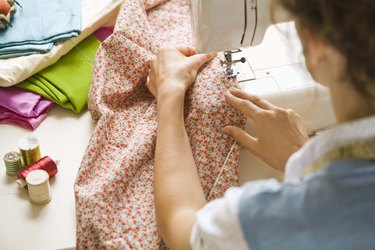Things You'll Need
Serger sewing machine
Sturdy fabric
1 serger spool of decorative thread
2 serger spools of woolly nylon thread (stretchy thread)
Scissors

A serger sewing machine adds versatile sewing and stitching methods to your sewing options. Sergers sew differently than standard sewing machines because these machines use up to five threads to stitch, remove excess seam allowances and overlock fabric edges simultaneously. Many people enjoy using a serger to create decorative stitching edges on fabrics. The blanket stitch looks beautiful when you sew it onto a fabric edge. While hand stitching the blanket stitch remains the standard way to create this decorative stitch, you can also form the blanket stitch on a serger.
Step 1
Remove the right needle from the serger temporarily. You will not use it to stitch the blanket stitch. Thread the left needle with the decorative thread. Thread both the lower and upper loopers with wooly nylon thread in any color. Wooly nylon thread makes ideal thread for sewing the blanket stitch with the serger because it stretches and it will pull the fabric edge under attractively.
Video of the Day
Step 2
Set the serger stitch to between 4 and 5. Set the tension of both loopers to 7.5 (you may have to make it tighter yet as you test the stitches). Set the needle tension to 1.
Step 3
Place your sturdy fabric into the serger. You can stitch right along the edge of the fabric or you can roll the edge of the fabric under approximately 3/8 inch. Stitch a test strip of the blanket stitch to assess the machine settings. If the looper threads do not stitch attractively around the edge of the fabric, make the looper tensions higher. Continue to test until the blanket stitch looks the way you desire.
Step 4
Stitch the decorative blanket stitch along the edge of the fabric on your project after testing the tension settings and finding satisfactory ones.
Tip
The looper thread tensions determine a satisfactory blanket stitch with the serger. High looper tensions will roll the fabric edge within the looper threads attractively. If you use a heavy needle thread, set your looper tensions even higher.
Video of the Day